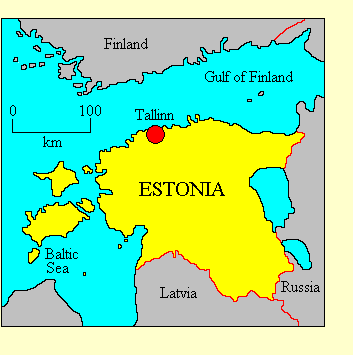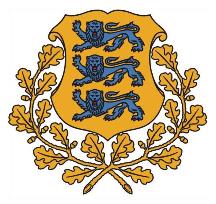

REPUBLIC OF ESTONIA
• Official name: Eesti Vabariik (Republic of Estonia)
• Location: Eastern Europe
• International organisations: Council of Europe, European Union, North Atlantic Treaty Organisation,
Organisation for Economic Co-operation and Development, Organisation for Security and Co-operation in Europe,
United Nations, World Trade Organisation
• Borders: Latvia, Russia
• Coastline: Baltic Sea, Gulf of Finland
• Land area: 45,226 Km2
• Population: 1,300,000
• Annual GDP (PPP) per capita: US$18,700 (2009 CIA estimate). World ranking: 48. Estonia is the wealthiest
of the former Soviet republics.
• Ethnicity: The Estonians are a Finno-Ugric people related to the Finns. They make up 65.3% of the
population. Other groups are Russians 28.1%, Ukrainians 2.5%, Belarusians 1.5%, and Finns 1%.
• Languages: Estonian is the official languages. Russian is widely spoken and Belarusian, Finnish and Ukrainian
are also spoken.
• Religion: The Estonians are Lutheran Protestant Christians, while the Russians and Ukrainians are mostly
Orthodox Christians.
• Form of government: Parliamentary democratic republic. Estonia is divided into 15 counties.
• Capital: Tallinn

• Constitution: The
Constitution of the Republic of Estonia came into effect on 28 June 1992.
• Head of state: The President, chosen by the legislature for a five-year term. The President's functions are
largely ceremonial. President
Toomas Hendrik Ilves took office on 9 October 2006.
• Head of government: The Prime Minister, appointed by the President. The Prime Minister is the leader of the
largest party or coalition of parties in the legislature and is accountable to it.
• Legislature: Estonia has a unicameral legislature, the Parliament of
Estonia (Riigikogu), which has 101 members elected for four-year terms from multi-member constituencies.
• Electoral authority: The Estonian National Election Committee administers
elections.
• Freedom House 2009 rating: Political Rights 1, Civil Liberties 1
Political history
Estonia was ceded by Sweden to the Russian Empire in 1721, and the area was heavily Russified over next two
centuries. Estonian national consciousness survived, however, and emerged as an independence movement following the
Russian Revolution of 1917. On 24 February 1918 the Republic of Estonia was proclaimed, and was recognised by the
Soviet Republic in 1920. Estonia was a parliamentary democracy until 1934, when Konstantin Pats established an
authoritarian regime. In 1940, under the terms of the Nazi-Soviet pact, Soviet forces entered the country and
Estonia became a Republic of the Soviet Union. German forces occupied the country in 1941, but Soviet rule was
re-established in 1944

In March 1990, as the Soviet Union disintegrated, the Estonian Supreme Soviet declared the 1940 annexation to be
invalid and the restoration of Estonian sovereignty. In March 1991 78% of Estonians voted for independence, although
most of the large Russian minority opposed it. The Soviet Union recognised Estonian independence in September 1991.
Since 1991 Estonia has become the most successful, politically and economically, of the former Soviet republics,
greatly helped by its close affinity with Finland. Estonia joined NATO and the European Union in 2004. Politically,
Estonia is the most conservative country in eastern Europe, having no significant left-wing party.
Currently politics are
dominated by the moderate Estonian Centre Party (KE) and the liberal
Estonian Reform Party RE), which form a coalition government. The
opposition is led by the conservative
Union of the Estonian People and
Estonian People's Union.
Andrus Ansip of the Reform Party has been Prime Minister since
April 2005.
Updated February 2010
|


